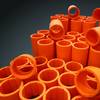The U. S. Military Sealift Command has chartered a 319-ft. (97.22M), high speed catamaran theater support vessel (TSV), now under construction at Hobart, Tasmania, Australia from Bollinger/Incat USA, LLC, for use as a test platform by the U. S. Navy’s Mine Warfare Command. The one-year lease has options for up to an additional 47 months and is the third similar vessel chartered from Bollinger/Incat by elements of the U. S. Department of Defense.
“We are delighted with this new contract,” said Chris Bollinger, President of Bollinger/Incat, “as it is an affirmation of positive, on-going test results of Incat hull 050, JOINT VENTURE (HSV-X1), the first vessel chartered by the U. S. Army’s TACOM (Tank Automotive and Armament Command) for tests and evaluations by the Army, Navy, Marine Corps, Coast Guard and SOCOM (Special Operations Command). We are confident these programs will lead to contracts for construction of these types of vessels at one of our Gulf Coast shipyards.”
Bollinger/Incat USA announced the charter of a second vessel, Incat hull 060, SPEARHEAD (TSV-1X) on October 29. It is in the final stages of construction in Australia and is being modified to meet certain U. S. Army requirements before its delivery in November, 2002. The third, and latest ship chartered, Incat hull 061, is also still under construction in Australia. Like the others, it was originally designed as a high speed, wave-piercing ferry capable of carrying a mix of hundreds of passengers, cars, trucks and other cargos over long distances.
Though yet unnamed, it is anticipated that its hull number will be HSV-X2, according to Navy spokeswoman Lt. Elissa Smith. It will be nearly identical to SPEARHEAD with a 319-foot (97.22M) length, 87.3-foot (26.60M) beam, and maximum depth of 11.15 feet (3.40 M). It will be powered by four Ruston 20RK270 marine engines, driving four Lips 120E waterjets through Reintjes gearboxes. It is scheduled for delivery in June 2003, and is expected to serve as an interim replacement for the USS INCHON (MCS-12), a Navy mine countermeasure ship.
The new ship is expected to deploy in September 2003 as the mine warfare and control ship according to Lt. Herlinda Rojas, a spokeswoman for the Mine Warfare Command. Within five months thereafter, the vessel will participate in exercises with the Atlantic Fleet Joint Task Force, the Pacific Fleet Joint Task Force, and in the Gulf of Mexico where it will serve as a platform for conducting a series of exercises and demonstrations for the Navy Warfare Development Command (NWDC) and the Marine Corps Combat Development Command (MCCDC).
The sleek ship will be capable of maintaining an average speed of 35 knots or greater, loaded with 500 short tons, consisting of 350 personnel and military equipment. A minimum operating range of 1100 nautical miles at 35 knots is required by the contract, as is a minimum transit range of 4,000 nautical miles at an average speed of 20 knots. It must also be capable of 24-hour operations at slow speeds (3-10 knots) for small boat and helicopter operations.
It will also be fitted with a stern ramp capable of on/off loading directly astern or to the starboard quarter. The ramp will be capable of loading and unloading a multitude of military vehicles up to and including battle tanks of up to 140,000 pounds. The ramp will also be capable of launch and recovery of amphibious assault vehicles. To achieve this, the ramp tip end will be submerged allowing the amphibious vehicles to drive on and off the ship.
The ship will also be capable of launching and recovery of small boats and unmanned vehicles up to 23,000 pounds while underway and in higher sea states than HSV-X1.
A NAVAIR certified helicopter deck is also being installed for operation of MH-60S Knighthawk multi-role, CH-46 Sea Knight medium-lift, UH-1 utility, and AH-1 Cobra attack helicopters. This deck will be capable of handling two helicopters, whereas HSV-X1 can accommodate one helicopter. A protected hanger for storage and maintenance of two MH-60S helicopters each equipped with a Carriage Stream Tow and Recovery System (CSTARS). The helicopter deck will have the capacity to transfer equipment up to 6,000 pounds to and from the vehicle deck.
The NWDC will evaluate the vessel’s modular mission packages, launch and recovery capabilities for vehicles and undersea vehicles, mine warfare, anti-submarine warfare and defense against swarming small ships, according to Cmdr. Dean Chase of the NWDC.
Lt. Smith said the Marine Corps will exercise the ship in seabasing operations, transferring equipment and personnel from a Maritime Prepositioning Force to developed and austere ports, causeway operations, and to support maneuvers in littoral and riverine operations.
Featured videos

Inside the Electrified Truckable Tug

Tracking Foreign Vessels Working in the U.S. Jones Act Market

Inmarsat Enhances Service to Drive Digitalization
Subscribe for
Maritime Reporter E-News
Maritime Reporter E-News is the maritime industry's largest circulation and most authoritative ENews Service, delivered to your Email five times per week









